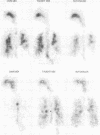Abstract
BACKGROUND The metered dose inhaler is difficult to use correctly, synchronising actuation with inhalation being the most important problem. A breath actuated pressurised inhaler, designed to help patients with poor inhaler technique, was compared with a conventional metered dose inhaler in terms of aerosol deposition and bronchodilator response. METHODS Radioaerosol deposition and bronchodilator response to 100 micrograms salbutamol were measured in 18 asthmatic patients, who inhaled from a conventional metered dose inhaler by their own chosen metered dose inhaler technique, from a conventional metered dose inhaler by a taught metered dose inhaler technique, and from a breath actuated pressured inhaler (Autohaler). RESULTS In the 10 patients who could coordinate actuation and inhalation of the inhaler on their own deposition of aerosol in the lungs and bronchodilator response were equivalent on the three study days. By contrast, in the eight patients who could not coordinate the mean (SEM) percentage of the dose deposited in the lungs with their own inhaler technique (7.2% (3.4%] was substantial lower than those attained by the taught metered dose inhaler technique (22.8% (2.5%] and by Autohaler (20.8% (1.7%]. CONCLUSION Although of little additional benefit to asthmatic patients with good coordination, the Autohaler is potentially a valuable aid to those with poor coordination, and should be considered in preference to a conventional metered dose inhaler in any patient whose inhaler technique is not known to be satisfactory.
Full text
PDF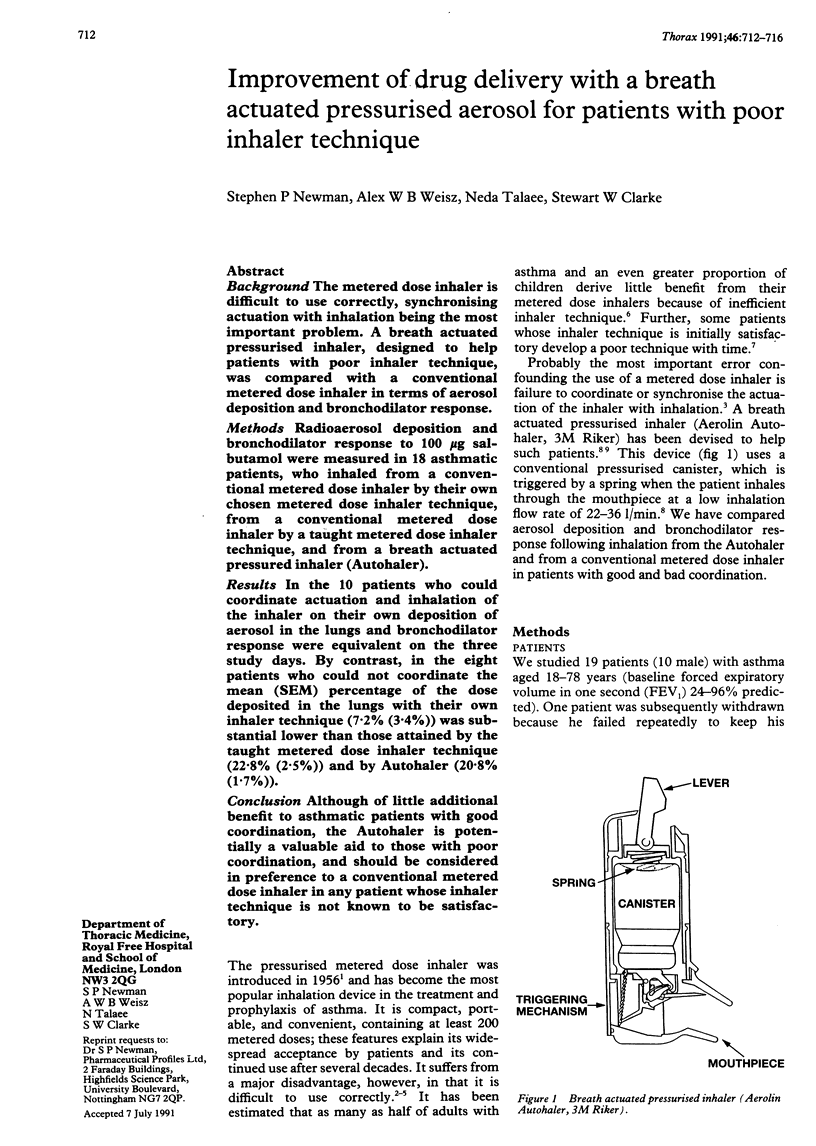
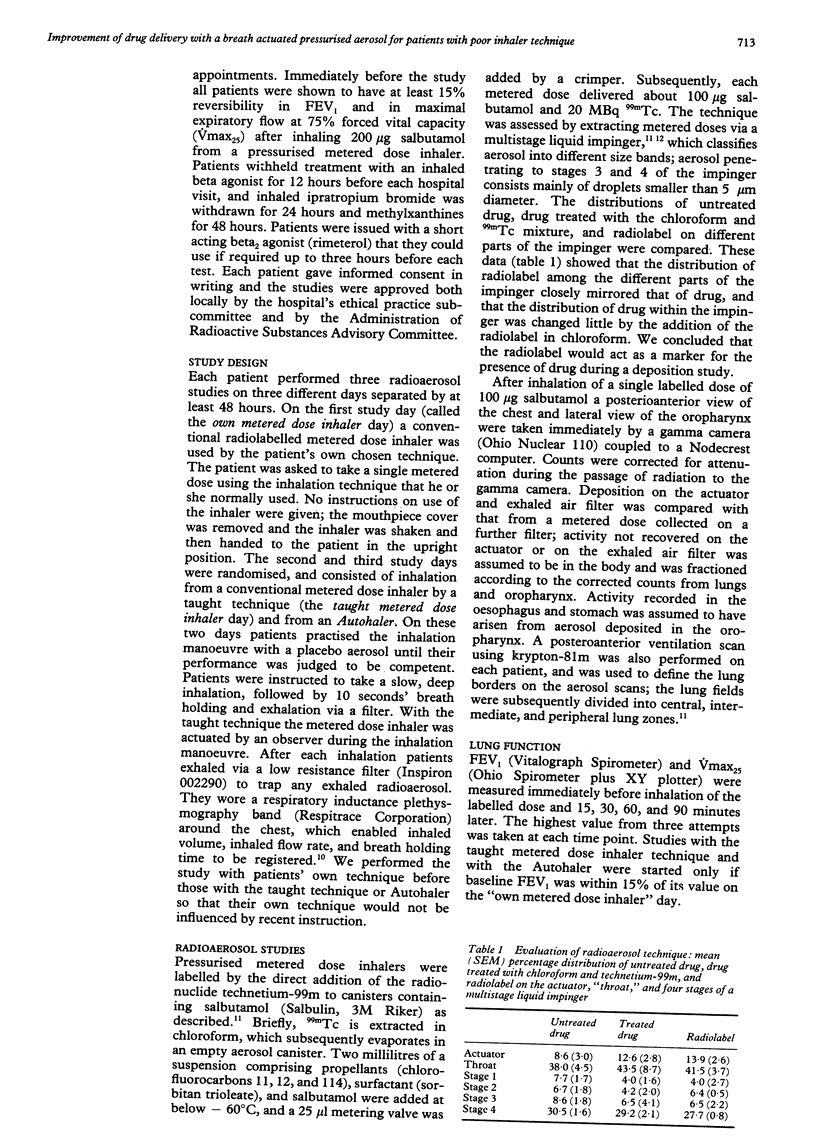
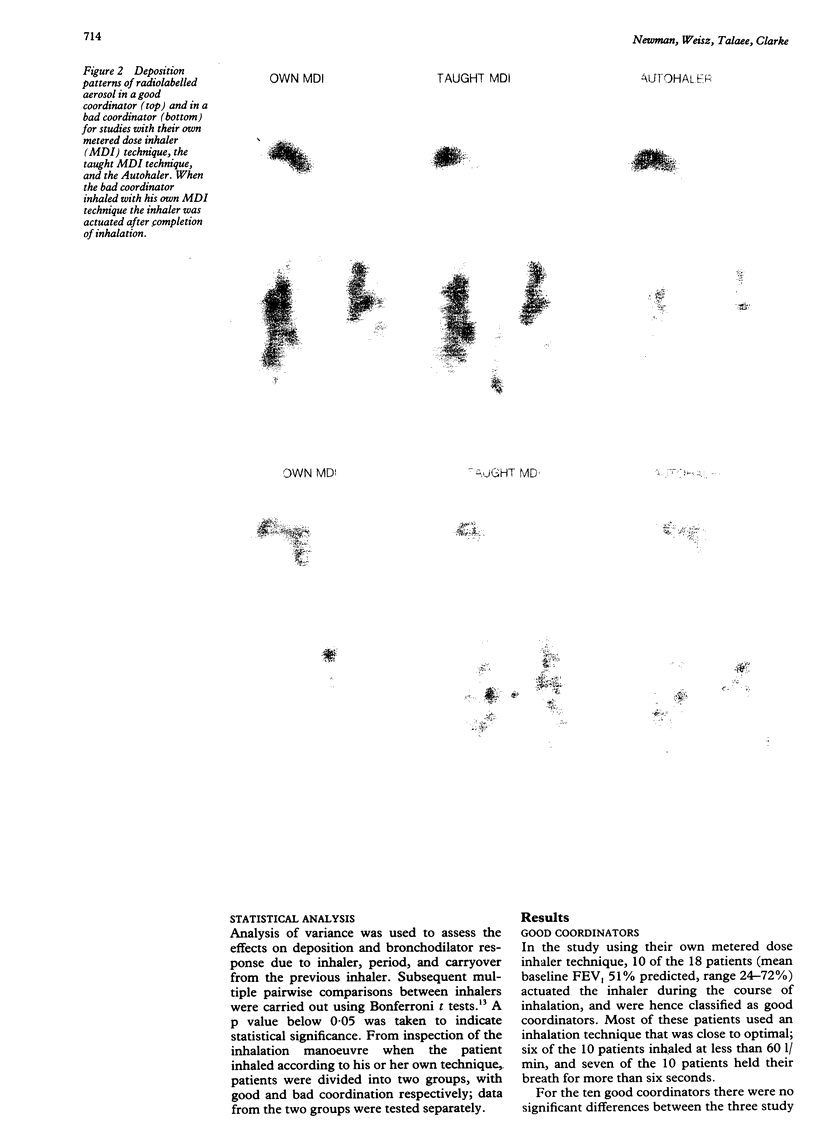
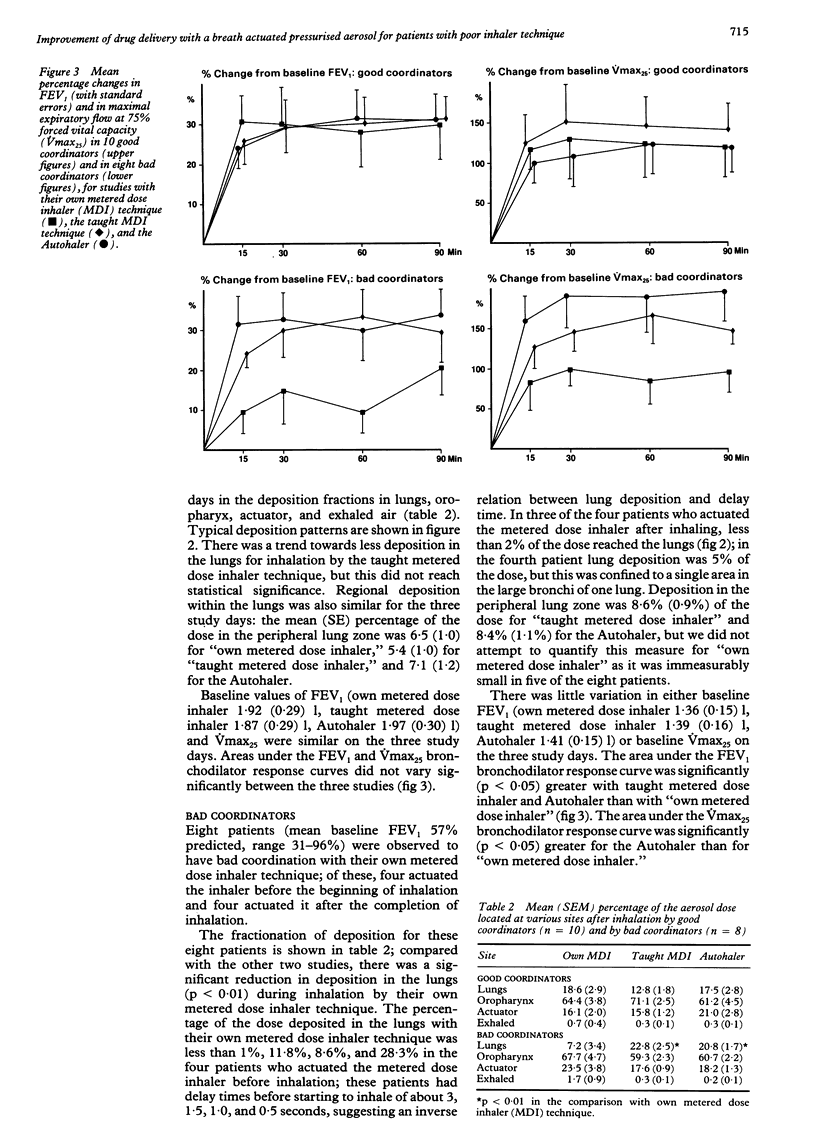
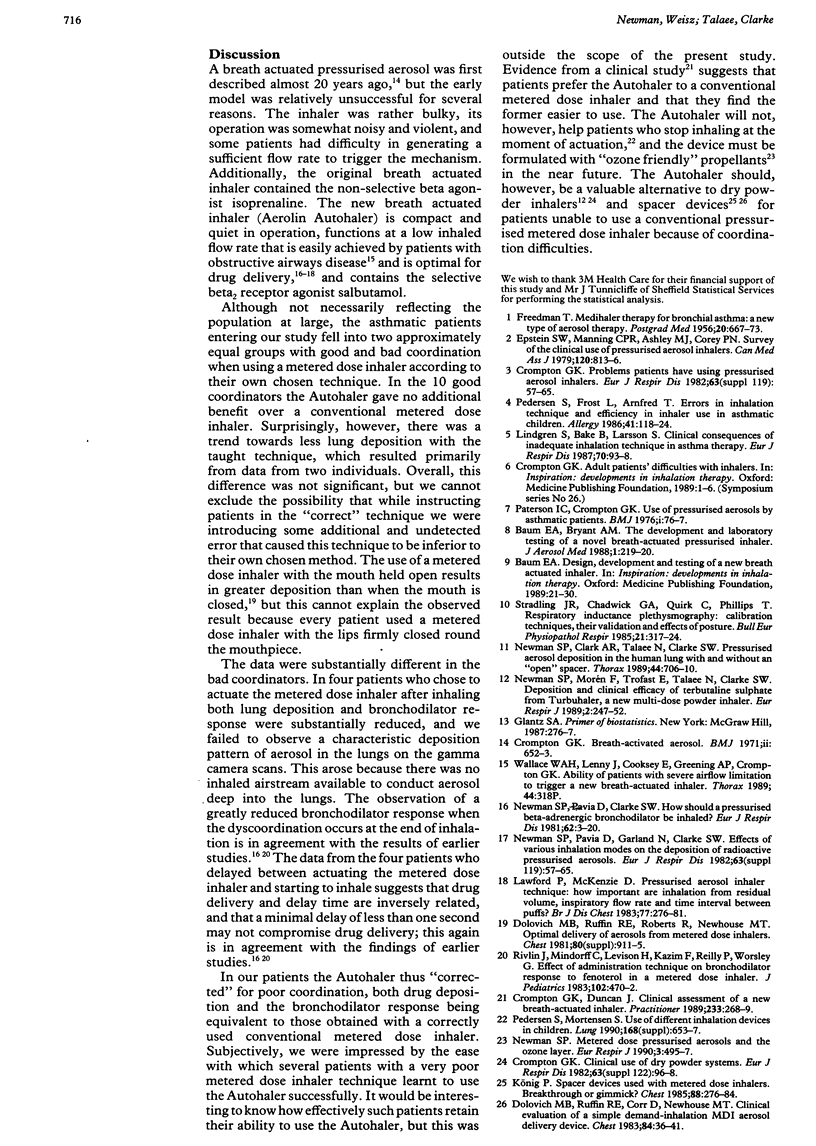
Images in this article
Selected References
These references are in PubMed. This may not be the complete list of references from this article.
- Crompton G. K. Breath-activated aerosol. Br Med J. 1971 Jun 12;2(5762):652–653. doi: 10.1136/bmj.2.5762.652-c. [DOI] [PMC free article] [PubMed] [Google Scholar]
- Crompton G. K. Clinical use of dry powder systems. Eur J Respir Dis Suppl. 1982;122:96–99. [PubMed] [Google Scholar]
- Crompton G., Duncan J. Clinical assessment of a new breath-actuated inhaler. Practitioner. 1989 Feb 22;233(1463):268–269. [PubMed] [Google Scholar]
- Dolovich M., Ruffin R. E., Roberts R., Newhouse M. T. Optimal delivery of aerosols from metered dose inhalers. Chest. 1981 Dec;80(6 Suppl):911–915. [PubMed] [Google Scholar]
- Dolovich M., Ruffin R., Corr D., Newhouse M. T. Clinical evaluation of a simple demand inhalation MDI aerosol delivery device. Chest. 1983 Jul;84(1):36–41. doi: 10.1378/chest.84.1.36. [DOI] [PubMed] [Google Scholar]
- Epstein S. W., Manning C. P., Ashley M. J., Corey P. N. Survey of the clinical use of pressurized aerosol inhalers. Can Med Assoc J. 1979 Apr 7;120(7):813–816. [PMC free article] [PubMed] [Google Scholar]
- FREEDMAN T. Medihaler therapy for bronchial asthma; a new type of aerosol therapy. Postgrad Med. 1956 Dec;20(6):667–673. doi: 10.1080/00325481.1956.11691366. [DOI] [PubMed] [Google Scholar]
- König P. Spacer devices used with metered-dose inhalers. Breakthrough or gimmick? Chest. 1985 Aug;88(2):276–284. doi: 10.1378/chest.88.2.276. [DOI] [PubMed] [Google Scholar]
- Lawford P., McKenzie D. Pressurized aerosol inhaler technique: how important are inhalation from residual volume, inspiratory flow rate and the time interval between puffs? Br J Dis Chest. 1983 Jul;77(3):276–281. [PubMed] [Google Scholar]
- Lindgren S., Bake B., Larsson S. Clinical consequences of inadequate inhalation technique in asthma therapy. Eur J Respir Dis. 1987 Feb;70(2):93–98. [PubMed] [Google Scholar]
- Newman S. P., Clark A. R., Talaee N., Clarke S. W. Pressurised aerosol deposition in the human lung with and without an "open" spacer device. Thorax. 1989 Sep;44(9):706–710. doi: 10.1136/thx.44.9.706. [DOI] [PMC free article] [PubMed] [Google Scholar]
- Newman S. P. Metered dose pressurized aerosols and the ozone layer. Eur Respir J. 1990 May;3(5):495–497. [PubMed] [Google Scholar]
- Newman S. P., Morén F., Trofast E., Talaee N., Clarke S. W. Deposition and clinical efficacy of terbutaline sulphate from Turbuhaler, a new multi-dose powder inhaler. Eur Respir J. 1989 Mar;2(3):247–252. [PubMed] [Google Scholar]
- Newman S. P., Pavia D., Garland N., Clarke S. W. Effects of various inhalation modes on the deposition of radioactive pressurized aerosols. Eur J Respir Dis Suppl. 1982;119:57–65. [PubMed] [Google Scholar]
- Paterson I. C., Crompton G. K. Use of pressurised aerosols by asthmatic patients. Br Med J. 1976 Jan 10;1(6001):76–77. doi: 10.1136/bmj.1.6001.76-a. [DOI] [PMC free article] [PubMed] [Google Scholar]
- Pedersen S., Frost L., Arnfred T. Errors in inhalation technique and efficiency in inhaler use in asthmatic children. Allergy. 1986 Feb;41(2):118–124. doi: 10.1111/j.1398-9995.1986.tb00287.x. [DOI] [PubMed] [Google Scholar]
- Pedersen S., Mortensen S. Use of different inhalation devices in children. Lung. 1990;168 (Suppl):653–657. doi: 10.1007/BF02718190. [DOI] [PubMed] [Google Scholar]
- Rivlin J., Mindorff C., Levison H., Kazim F., Reilly P., Worsley G. Effect of administration technique on bronchodilator response to fenoterol in a metered-dose inhaler. J Pediatr. 1983 Mar;102(3):470–472. doi: 10.1016/s0022-3476(83)80680-5. [DOI] [PubMed] [Google Scholar]
- Stradling J. R., Chadwick G. A., Quirk C., Phillips T. Respiratory inductance plethysmography: calibration techniques, their validation and the effects of posture. Bull Eur Physiopathol Respir. 1985 Jul-Aug;21(4):317–324. [PubMed] [Google Scholar]



